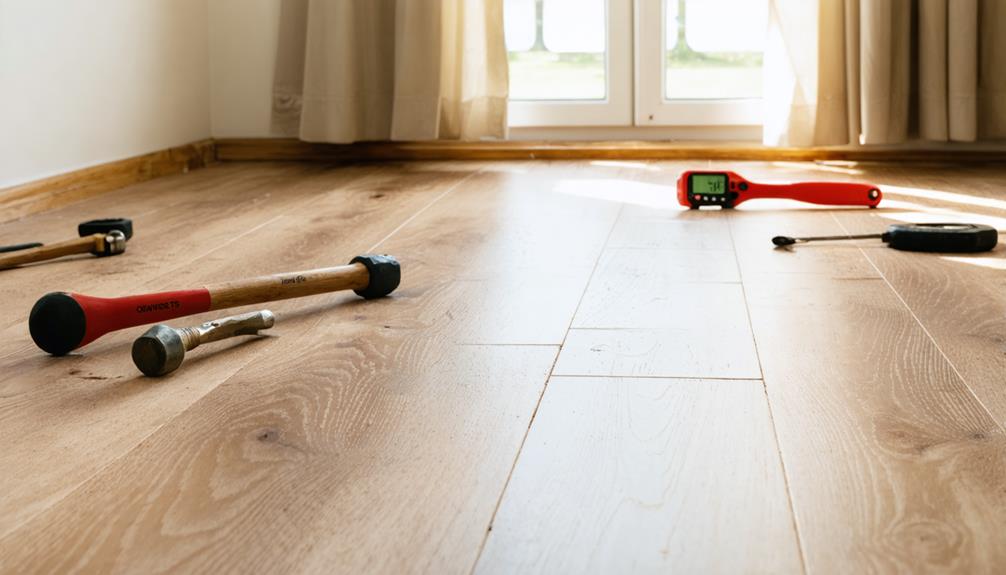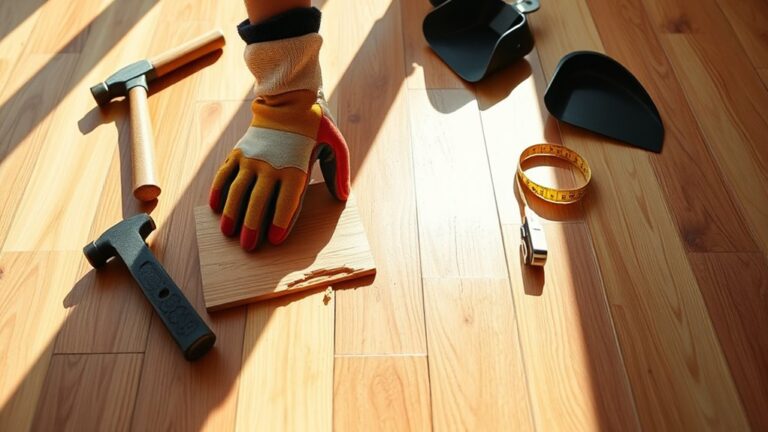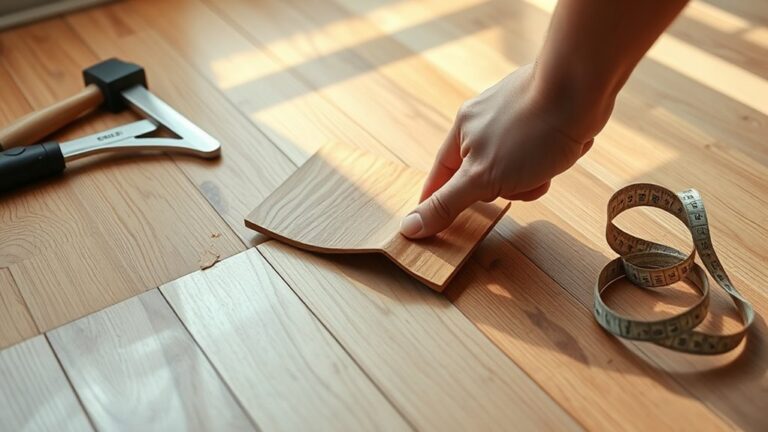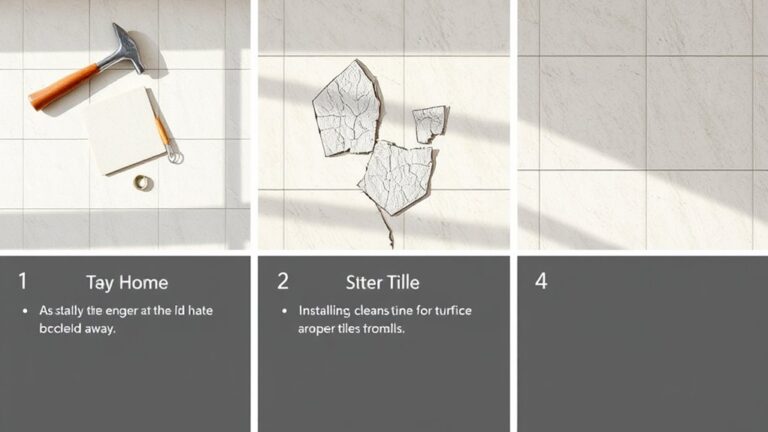To fix warped LVP flooring, first identify moisture sources like leaks or high humidity. For minor warping, use a heat gun to gently soften affected areas, then place a heavy object to flatten them. If warping is severe, you may need to remove and replace damaged planks, applying adhesive as necessary. Verify the subfloor is level and moisture barriers are in place during installation. Regular maintenance, including swift spill management and using protective pads under furniture, prevents future issues. Explore additional techniques and preventive measures to keep your flooring in prime condition.
Understanding Warped LVP Flooring
When dealing with warped LVP flooring, it's important to understand the underlying causes and signs that indicate a problem. Warping often stems from excessive moisture exposure and temperature fluctuations, which lead to the expansion and contraction of the material. If you've noticed the edges of your planks lifting, bubbling, or visible distortions on the surface, these are clear signs of warping that require your attention.
High humidity levels and water spills can seep into the seams of the flooring, exacerbating the issue, especially in poorly ventilated areas. To prevent this, you should regularly inspect your flooring for any early signs of warping. Identifying these issues before they escalate can save you from costly repairs and replacements.
Proper acclimation of LVP flooring is vital prior to installation. It's recommended that you allow the planks to adjust to the room's temperature and humidity for 24-48 hours. This foundational step can greatly reduce the risk of warping over time.
Maintaining a stable environment is also key; fluctuations in temperature can trigger the expansion and contraction of LVP, leading to potential issues. By keeping your home's climate controlled and addressing moisture exposure promptly, you can enjoy the aesthetic and functional benefits of your flooring without the burden of warping. Remember, being proactive in your flooring care is essential for preserving its integrity and longevity.
Common Causes of Warping
Warping in LVP flooring can be attributed to several common causes that often stem from environmental and installation factors. One of the primary culprits is excessive moisture retention. Spills, leaks, or high humidity can seep into the seams of your flooring, leading to expansion and subsequent warping. It's vital to monitor moisture levels in your home to prevent this issue.
Improper installation techniques also play a significant role. Uneven subfloors or inadequate adhesive application can create instability in the vinyl planks, making them more susceptible to warping. Ensuring a proper installation is essential for maintaining the integrity of your flooring.
Another factor contributing to warping is temperature fluctuations. Areas exposed to direct sunlight can cause the vinyl planks to expand and contract with changing temperatures, which may lead to warping over time. It's advisable to use window treatments or UV-blocking films to mitigate this effect.
Lastly, heavy furniture or appliances can create stress on the flooring. When placed directly on LVP without protective pads, they can cause indentations and warping. To avoid this, consider using furniture coasters or pads to distribute weight evenly.
Understanding these common causes can help you take proactive measures to prevent warping in your LVP flooring. By managing moisture levels, ensuring proper installation, controlling temperature exposure, and using protective measures for heavy items, you can maintain the beauty and functionality of your flooring.
Assessment Before Repair
Before you start repairs, you need to assess the damage severity and check moisture levels. Look for any signs of water damage or leakage that could be causing the warping, as addressing these issues is essential. Additionally, evaluate how much the planks have warped to determine if simple adjustments or more extensive repairs are necessary.
Identify Damage Severity
To effectively address warped LVP flooring, it is crucial to first assess the severity of the damage. Begin by inspecting the edges of the planks; if they're lifting or if you see noticeable bubbles or ridges, you've got a clear indication of warp. Next, determine whether the issue is localized to specific affected planks or if it's widespread, affecting multiple areas of the flooring. This distinction will help you decide on the best course of action.
You should also check for potential moisture sources, as water damage is a common culprit behind warping. Look for signs of water leaks, high humidity levels, or dampness in the subfloor that could be contributing to the problem.
Check Moisture Levels
Evaluating moisture levels in the subfloor and surrounding environment is essential for a successful repair of warped LVP flooring. Start by using a moisture meter to assess the moisture levels in the subfloor. If the reading exceeds the recommended moisture level—typically around 12%—you'll need to address moisture mitigation before proceeding with any repairs.
Next, inspect the area for visible signs of water damage, such as discoloration or mold, which could indicate ongoing moisture issues that require immediate attention. Additionally, look for potential sources of humidity, including leaks from plumbing fixtures or inadequate ventilation. These factors can contribute to elevated moisture levels and exacerbate warping.
Particularly in high-humidity areas like basements and bathrooms, regularly monitoring moisture levels is vital. By maintaining appropriate moisture levels, you can prevent future warping and uphold the integrity of your flooring. Ignoring moisture issues could lead to further damage and costly repairs down the line. Taking these steps not only helps you fix the current problem but also empowers you to safeguard your flooring for the future.
Repair Techniques for Minor Warping
Minor warping in luxury vinyl plank (LVP) flooring can often be remedied with a few effective techniques. One common method involves using a heat gun. Carefully apply heat to the affected area, which softens the vinyl and allows you to reshape it back to its original form. Be cautious not to overheat, as this can damage the vinyl flooring.
Another technique is to place a heavy object on the warped section for several days. This weight helps flatten the vinyl, encouraging it to return to its original shape. Before doing this, take into account lightly warming the area with a damp cloth to enhance effectiveness. The added warmth can make the vinyl more pliable, improving your chances of a successful repair.
It's essential to address any moisture sources in your environment, as persistent dampness can exacerbate warping, even in minor cases. After you've performed your repairs, regularly monitor the area for signs of recurring warping. If you notice ongoing issues, it might indicate a need to further evaluate your flooring's condition.
In some situations, if the minor warping doesn't improve with these techniques, you may need to reflect on whether you can repair or replace the affected planks. Always remember that addressing the underlying causes of warping is vital to prevent future problems. By following these techniques, you can often restore your LVP flooring to its original state and maintain its aesthetic appeal.
Solutions for Major Warping
While minor warping can often be addressed with simple techniques, severe cases require a more thorough approach. Start by removing the affected planks to assess the extent of the damage. This step is vital, as it helps you determine whether you need to replace any planks or if repairs can restore the floor's integrity.
If moisture is identified as the cause of warping, it's important to eliminate the source. Check for leaks or high humidity levels, as these can lead to recurring issues. Once the cause is addressed, reapply new adhesive to the edges of the planks before reinstalling them. This guarantees a secure fit, minimizing the risk of future lifting.
In areas prone to warping, consider using transition strips or molding for additional support. These features can accommodate natural expansion and contraction, helping to stabilize the flooring. If you find that warping persists despite your repairs, replacing the entire flooring may be the most effective solution. In such cases, consulting a professional may be prudent, as they can provide expertise and guarantee the job is done correctly.
Ultimately, addressing major warping effectively involves a combination of assessment, moisture management, and proper installation techniques. By following these steps, you can restore the functionality and appearance of your LVP flooring, maintaining the freedom to enjoy your space without the worry of continuous flooring issues.
Recommended Adhesives for Repairs
When it comes to repairing warped LVP flooring, selecting the right adhesive is essential for guaranteeing a lasting fix. The correct adhesive not only helps secure the planks but also withstands the challenges posed by moisture and environmental changes. Here are some recommended adhesives for your repairs:
- Gorilla Glue Clear: This waterproof adhesive is perfect for small areas of repair. It provides a strong bond that can endure moisture exposure, making it ideal for minor fixes.
- Titebond III: Known for its waterproof properties, Titebond III is excellent for reattaching planks. Its durability assures that your repairs hold up even in high-moisture environments.
- Clear Water-Based Caulk: This option is effective for filling gaps in lifting planks, allowing for a clean finish without visible residue. It's perfect for achieving a seamless look while addressing minor warping issues.
- Contact Cement: If your LVP flooring is glued down, contact cement is your go-to. It provides a strong bond that can help secure warped planks back into place, guaranteeing stability.
- Polyseamseal®: This clear adhesive works well in tight spaces and can help prevent further lifting issues by effectively sealing seams.
Using these recommended adhesives can greatly improve the outcome of your repairs, guaranteeing that your warped LVP flooring remains secure and visually appealing.
Preventative Measures for Warping
Preventing warped LVP flooring requires careful attention to several key factors. First and foremost, controlling moisture levels in your environment is essential. Clean up spills immediately and consider using dehumidifiers in areas prone to high humidity, such as basements and bathrooms. Excess moisture can lead to warping, so maintaining ideal humidity levels is necessary.
During installation, it's critical to apply moisture barriers, especially in moisture-sensitive areas like kitchens and bathrooms. These barriers protect your flooring from potential water damage, greatly reducing the risk of warping. Additionally, make certain that your subfloor is properly prepared—clean, dry, and level. Any imperfections in the subfloor can lead to uneven surfaces that may warp over time.
Another important step is acclimating your vinyl flooring to the room's temperature and humidity for 24-48 hours before installation. This process allows the flooring to adjust, preventing post-installation expansion or contraction due to temperature changes.
If you're using glue-down vinyl flooring, always choose the appropriate adhesive. Using the wrong type can result in lifting, which can subsequently lead to warping.
Maintaining Your LVP Flooring
To maintain your LVP flooring, you need to establish routine cleaning practices and protect high-traffic areas effectively. Regularly sweeping or vacuuming will help prevent dirt accumulation that can scratch the surface. Additionally, using furniture pads and mats in busy zones can minimize wear and prolong the life of your flooring.
Routine Cleaning Practices
Maintaining your LVP flooring's pristine condition requires consistent routine cleaning practices that protect against dirt and damage. By following these steps, you can guarantee your vinyl flooring remains in excellent shape and prevents potential issues.
- Regular Sweeping or Vacuuming: Make it a habit to sweep or vacuum your LVP flooring regularly. This helps prevent dirt and debris from embedding, which can lead to scratches and wear over time.
- Use a Microfiber Mop: Clean your floors with a microfiber mop and a cleaner specifically designed for LVP. This maintains the floor's appearance without damaging its surface.
- Avoid Harsh Chemicals: Steer clear of harsh chemicals and abrasive scrubbers. These can scratch and degrade the protective layer of your vinyl flooring.
- Immediate Spill Management: Wipe up spills immediately to prevent moisture absorption. This is essential, as prolonged exposure can lead to warping or other damage.
Lastly, remember to conduct routine inspections for signs of wear, such as scratches or lifting edges, to address any issues promptly and maintain the integrity of your LVP flooring.
Protecting High-Traffic Areas
Routine cleaning practices set the foundation for preserving the quality of your LVP flooring, but protecting high-traffic areas is equally important for long-term durability. To minimize wear, consider placing area rugs or mats in these zones. They absorb impact and help maintain the appearance and integrity of your vinyl flooring.
Utilizing furniture pads under heavy items is essential for distributing weight evenly, which prevents indentations that could lead to warping or damage. Regular cleaning in high-traffic areas is vital; use a soft broom or microfiber mop to remove dirt and debris that can embed into the surface and cause deep scratches.
Additionally, training pets to minimize scratching and digging will greatly reduce wear in frequently used areas. Implementing a "no shoes" policy can also be beneficial, as it limits the introduction of dirt and small stones that often lead to scratches. By applying these practices, you'll prolong the life of your flooring, ensuring it remains beautiful and functional for years to come. Prioritize these preventive measures to enjoy the freedom of a well-maintained living space that stands up to everyday use.
When to Seek Professional Help
Often, homeowners may find themselves uncertain about when to seek professional help for warped LVP flooring. While minor warping can sometimes be addressed with DIY methods, there are specific situations where it's vital to call a professional. Here are four key indicators:
- Severe Warping: If you notice extensive lifting or severe warping that simple remedies don't fix, it's time to consult a professional. They can assess the damage and recommend the best course of action.
- Persistent Issues: If DIY methods, like using heat or heavy objects, haven't worked after multiple attempts, seeking professional help is advisable. This can prevent further damage to your vinyl flooring.
- Underlying Problems: Professionals are trained to identify underlying issues, such as moisture problems or improper installation, that may not be obvious to you. Their expertise can save you time and money in the long run.
- Replacing Affected Planks: When considering replacing the affected planks due to extensive warping, professionals guarantee that the new pieces match your existing flooring and are installed correctly to avoid future issues.
Additionally, if you're unsure about how DIY repairs might impact your warranty, consulting a flooring contractor can provide clarity. Ultimately, knowing when to call a professional can help you maintain the integrity of your flooring and avoid costly mistakes.
Frequently Asked Questions
How to Flatten Warped Vinyl Plank Flooring?
Isn't it ironic how something meant to enhance your space can turn into a hassle? To flatten warped vinyl plank flooring, focus on moisture management first. Identify and eliminate any moisture sources. For minor warping, applying weight can help. If it persists, consider gentle heat with careful temperature control. Ensuring proper installation techniques can prevent future issues. Remember, maintaining a stable environment is essential for keeping your flooring looking its best.
Why Is My Vinyl Plank Flooring Warping?
If your vinyl plank flooring is warping, it could stem from several causes of warping. Excessive moisture exposure is a major factor, making moisture control essential. Installation mistakes, like uneven subfloors or inadequate adhesive, can also contribute considerably. Additionally, temperature fluctuations and heavy furniture can exacerbate the issue. To maintain your flooring's integrity, guarantee proper installation and manage moisture levels effectively to prevent future warping.
How Do You Fix Bowing Vinyl Plank Flooring?
To fix bowing vinyl plank flooring, start by identifying the causes of bowing, usually linked to moisture or improper installation. You'll need tools like a heat gun and heavy objects to gently reshape the planks. After addressing moisture issues, place a weight on the affected area for several days. For preventing future warping, guarantee proper acclimation and maintain consistent humidity levels to create a stable environment for your flooring.
How Do You Flatten a LVP Floor?
If you're dealing with a warped LVP floor, start by addressing humidity control. For instance, imagine your friend Sarah; after an LVP installation, her living room warped due to high moisture. She learned that proper flooring maintenance includes monitoring humidity levels. To flatten the floor, apply weight to the warped area and consider using heat. This combination can help reshape the vinyl, restoring its original appearance and ultimately enhancing your space's comfort and appeal.




